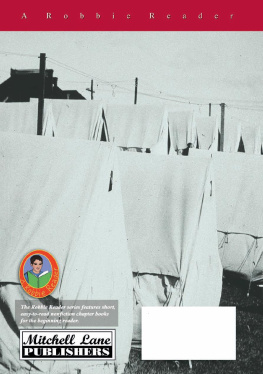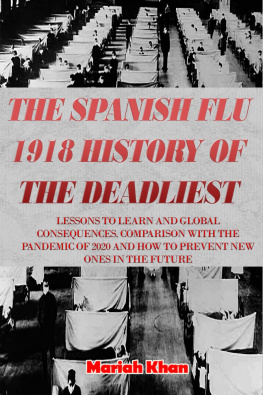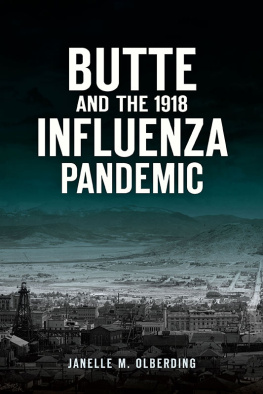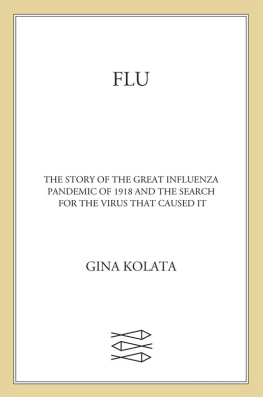Contents
Landmarks
List of Figures
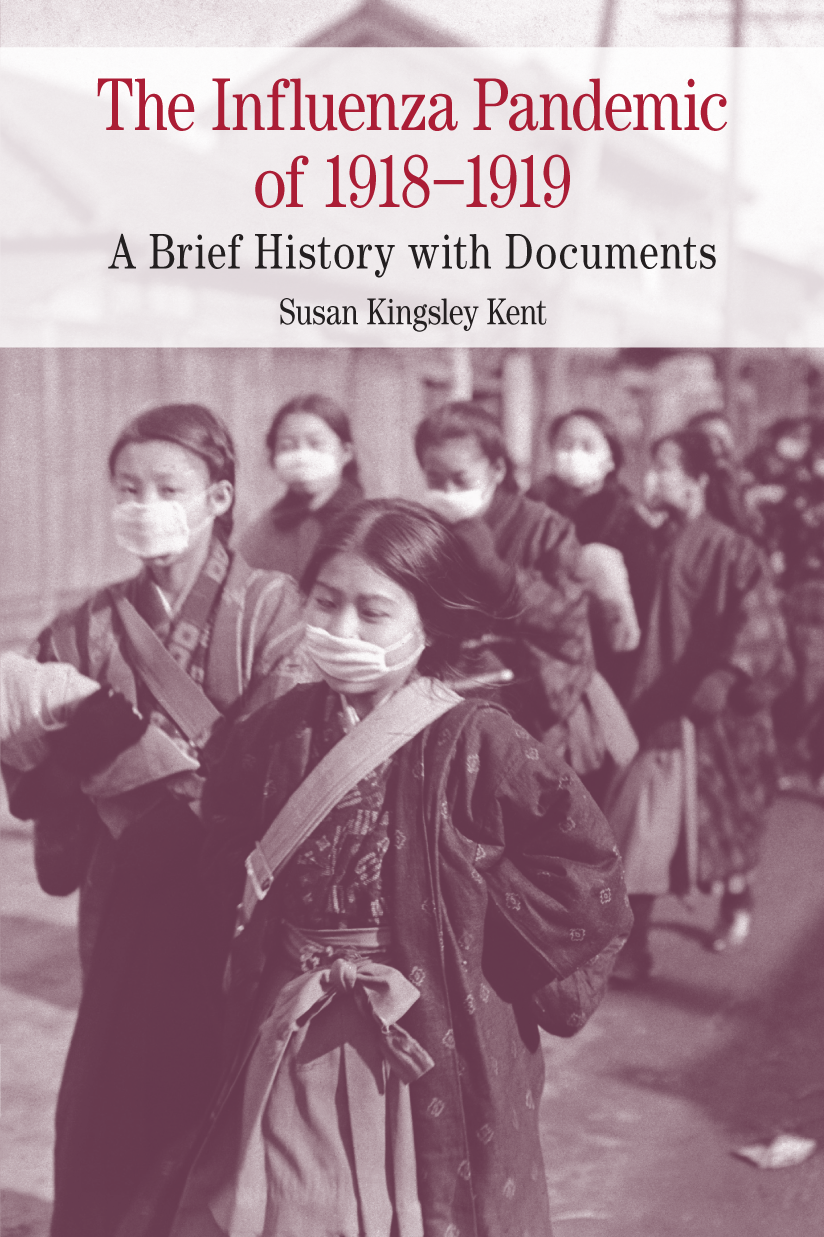
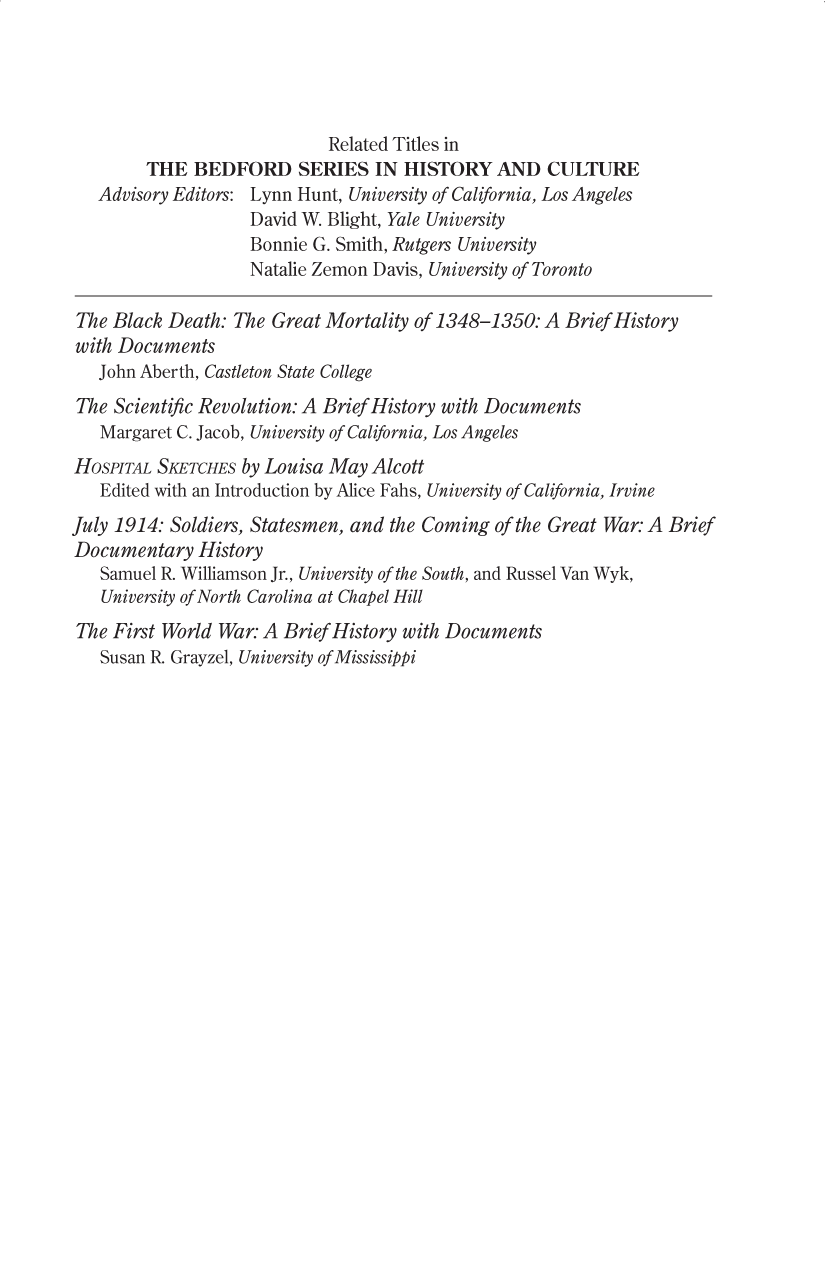
THE BEDFORD SERIES IN HISTORY AND CULTURE
The Influenza Pandemic of 19181919
A Brief History with Documents
- Susan Kingsley Kent
- University of Colorado, Boulder

For Bedford/St. Martins
Publisher for History: Mary V. Dougherty
Executive Editor for History: Traci M. Crowell
Director of Development for History: Jane Knetzger
Senior Editor: Heidi L. Hood
Developmental Editor: Ann Kirby-Payne
Production Supervisor: Lisa Chow
Executive Marketing Manager: Jenna Bookin Barry
Editorial Assistant: Laura Kintz
Project Management: Books By Design, Inc.
Cartography: Mapping Specialists, Ltd.
Permissions Manager: Kalina K. Ingham
Text Designer: Claire Seng-Niemoeller
Cover Designer: Marine Miller
Cover Photo: Japanese schoolgirls wear protective masks to guard against the influenza outbreak in Tokyo, February 17, 1920. Bettmann/Getty Images.
Composition: Achorn International, Inc.
President, Bedford/St. Martins: Denise B. Wydra
Presidents, Macmillan Higher Education: Joan E. Feinberg and Tom Scotty
Director of Marketing: Karen R. Soeltz
Director of Production: Susan W. Brown
Associate Production Director: Elise S. Kaiser
Manager, Publishing Services: Andrea Cava
Library of Congress Control Number: 2012939219
Copyright 2013 by Bedford/St. Martins
All rights reserved. No part of this book may be reproduced, stored in a retrieval system, or transmitted in any form or by any means, electronic, mechanical, photocopying, recording, or otherwise, except as may be expressly permitted by the applicable copyright statutes or in writing by the Publisher.
For information, write: Bedford/St. Martins, 75 Arlington Street, Boston, MA 02116
ISBN: 978-1-319-24162-9 (ePub)
Acknowledgments
Acknowledgments and copyrights are continued at the back of the book on , which constitutes an extension of the copyright page. It is a violation of the law to reproduce these selections by any means whatsoever without the written permission of the copyright holder.
Foreword
The Bedford Series in History and Culture is designed so that readers can study the past as historians do.
The historians first task is finding the evidence. Documents, letters, memoirs, interviews, pictures, movies, novels, or poems can provide facts and clues. Then the historian questions and compares the sources. There is more to do than in a courtroom, for hearsay evidence is welcome, and the historian is usually looking for answers beyond act and motive. Different views of an event may be as important as a single verdict. How a story is told may yield as much information as what it says.
Along the way the historian seeks help from other historians and perhaps from specialists in other disciplines. Finally, it is time to write, to decide on an interpretation and how to arrange the evidence for readers.
Each book in this series contains an important historical document or group of documents, each document a witness from the past and open to interpretation in different ways. The documents are combined with some element of historical narrativean introduction or a biographical essay, for examplethat provides students with an analysis of the primary source material and important background information about the world in which it was produced.
Each book in the series focuses on a specific topic within a specific historical period. Each provides a basis for lively thought and discussion about several aspects of the topic and the historians role. Each is short enough (and inexpensive enough) to be a reasonable one-week assignment in a college course. Whether as classroom or personal reading, each book in the series provides firsthand experience of the challengeand funof discovering, recreating, and interpreting the past.
Lynn Hunt
David W. Blight
Bonnie G. Smith
Natalie Zemon Davis
Preface
Appearing in the midst of the First World War, the influenza virus of 19181919 blazed across the globe in a matter of months, leaving in its wake a death toll that would surpass that of the war itself. It appeared suddenly and with explosive impact, and defied all previous understandings of the disease: the illness struck quickly and without warning, felling people in their homes, at work, and in the streets, and unlike previous manifestations of the disease, which tended to take infants and the elderly, this strain primarily struck men and women in the prime of their lives. Especially virulent, it moved quickly through homes, military barracks, cities, and towns, first appearing in the American Midwest and quickly making its way to South America, Africa, Europe, Asia, and Australia. Doctors and other medical professionals were helpless to understand or treat it, and governments were unable to contain or manage it. By the time the virus died out in the fall of 1919, it had taken the lives of up to sixty million people. Like the war, the pandemic shook the foundations of individuals, families, and entire societies around the globe, and its impact would continue to be felt throughout the first half of the twentieth century.
Despite its global impact, the pandemic is basically unknown to many students today. Designed for students enrolled in a variety of courses from surveys of global history to courses on health and medicine, World War I and beyond, this accessible and engaging collection invites critical thought on the connections between public health, economics, politics, and historical events.
The introduction to the volume provides a compelling, brief overview of the pandemic, including a thorough description of its physical symptoms and an examination of how and where it spread, as well as insights into the medical communitys understanding ofand response tothe disease. The short- and long-term impacts of the pandemicfrom the lives of children orphaned by the flu to colonial rebellions for which the pandemic served as a major catalystare also discussed.
The introduction is supported by more than sixty documents organized in four sections: The Nature and Experience of the Disease; Transmission and Mortality; Treatment Responses; and Consequences and Repercussions of the Pandemic. The documents include firsthand accounts from doctors and nurses who struggled to cope with this new strain of influenza while they treated patients ranging from anonymous rural Japanese villagers to the President of the United States. Along with newspaper accounts, government notices and statistical surveys, and memoirs and novels written by survivors, this collection of primary sources offers a glimpse into the experience of the pandemic as it unfolded, as well as its impact on individuals, communities, and entire populations in the decades that followed. To illustrate the truly global nature of the disease, the sources report on experiences from a wide range of countries, including the United States, Ireland, South Africa, Sweden, India, Nigeria, China, Sierra Leone, Germany, and beyond. Illuminating headnotes and gloss notes provide necessary context and background, while a chronology of events, questions for consideration, and a selected bibliography enhance and enrich student understanding.


